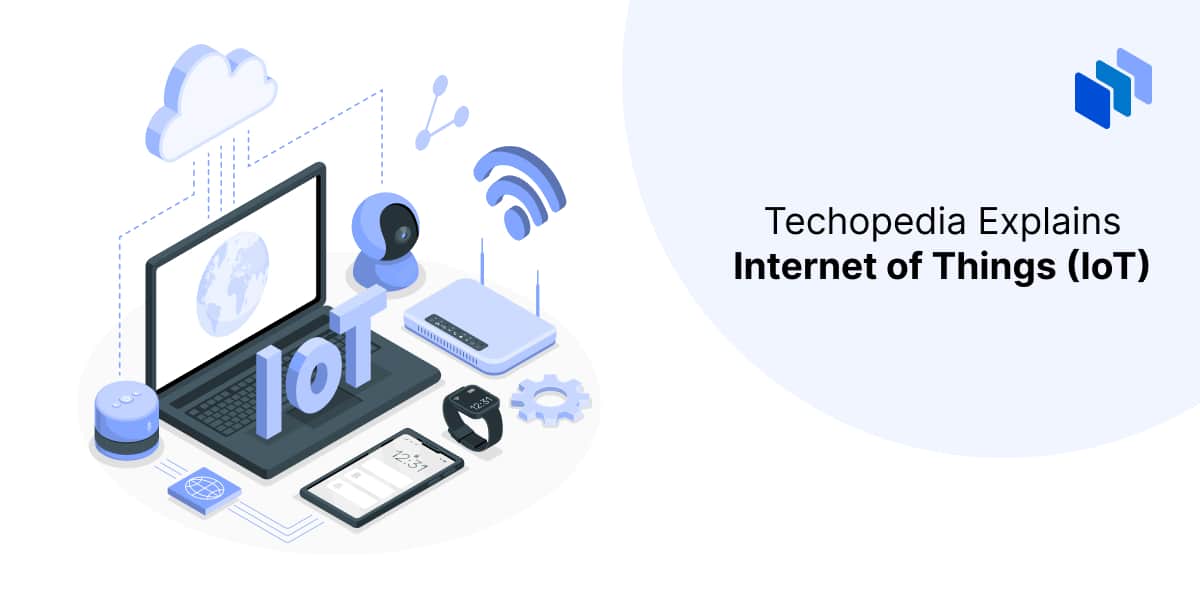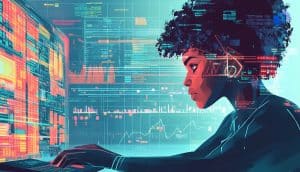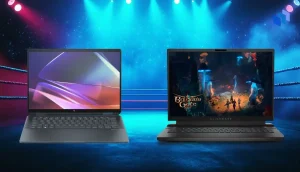What is the IoT (Internet of Things)?
The Internet of Things (IoT) is a network of interconnected devices that can collect and share data over the Internet with minimal human involvement. In this context, a “thing” is an object that has a unique identifier and the ability to communicate over a network.
Early IoT network nodes were only capable of one-way communication. Their function was to collect data from sensors and send it to a central location for processing and analysis. (A sensor is an electronic device that can detect or measure a physical property and convert it into an electrical signal.)
Today, an increasing number of IoT devices are capable of two-way communication and have actuators that allow them to complete actions in response to data rules or commands. This is just one advancement that has extended the capabilities of IoT devices and their applications in the real world.

Key Takeaways
- The Internet of Things is transforming how we live, work, and interact with the world around us.
- IoT devices are defined by their ability to connect to the internet and each other.
- IoT systems are vulnerable to cyberattacks.
- IoT devices generate large amounts of data that can be analyzed for insights.
- As the IoT expands, challenges related to interoperability, scalability, and security are becoming more important.
History of IoT
The roots of the Internet of Things can be traced back to the 1970s when students at Carnegie Mellon University connected micro-switches and a temperature sensor to a Coca-Cola vending machine.
The data from the micro-switches and temperature sensor was sent to a server program that could be accessed remotely over the university network. This allowed the students to check the inventory and temperature of the vending machine from their computers, saving them a trip if the machine was out of stock or the colas were not cold enough.
This setup, while rudimentary by today’s standards, was groundbreaking at the time and laid the foundation for the Internet of Things as we know it today.
How the Internet of Things Works
The Internet of Things consists of objects whose sensors, programming, and connectivity capabilities allow them to collect and share data with other devices and systems. The sensor’s job is to detect and measure environmental conditions or physical characteristics, such as temperature or location.
Some IoT devices have built-in processing capabilities that allow them to perform preliminary data processing locally. In this case, the device would filter out unnecessary data and compress important data for easier transmission.
It might also be able to make decisions locally to reduce latency and conserve bandwidth before sending important data to an IoT gateway or directly to a cloud computing platform for further analysis or action. This approach, which is called edge computing, can accommodate scalable and efficient data handling for a fleet of multiple IoT devices.
Major Components of the IoT Ecosystem
The Internet of Things ecosystem is composed of several major components that work together. They include:
Technologies Behind IoT

The Internet of Things has been made possible by a convergence of multiple technologies, each of which has contributed to the development and expansion of IoT applications and capabilities.
Advances in microprocessors, microcontrollers, and peripheral interface controllers (PICs) have enabled more powerful computing capabilities in smaller devices, while improvements in wireless communication technologies have facilitated the connectivity of these devices over the internet.
Additionally, the proliferation of smaller, more energy-efficient sensors has enabled the development of new IoT applications in areas where size, weight, and power constraints were previously limiting factors.
Developments in artificial intelligence, big data analytics, and mobile edge computing (MEC) have provided the infrastructure and computational power necessary to process, store, and analyze the vast amounts of data generated by IoT devices. Together, these technological advancements have laid the foundation for the wide range of IoT applications and capabilities we use today.
IoT Standards
Organizations like the Institute of Electrical and Electronics Engineers (IEEE), the International Electrotechnical Commission (IEC), and the International Telecommunication Union (ITU) are actively developing and maintaining IoT standards to address issues like security, privacy, reliability, and energy efficiency.

Applications of IoT
The Internet of Things has a wide range of applications across various industries. Here are some notable use cases:
IoT technology is increasingly being used to automate and remotely control a wide variety of smart home appliances, utilities, and security systems.
Smart devices like fitness trackers and smartwatches can be used to monitor health metrics such as heart rate, steps taken, and sleep quality. More advanced wearable devices can monitor specific health conditions like sugar levels, provide reminders for medication, and even alert healthcare providers in emergencies.
IoT applications in smart cities include traffic management systems that can reduce congestion, smart grids for more efficient energy use, water management systems to reduce waste, and public safety systems that use sensors and cameras to enhance security.
IoT devices can be used to monitor and optimize production processes in manufacturing and industrial settings. They can also be used to manage supply chains and predict maintenance needs for equipment.
IoT technologies play an important role in precision farming. IoT sensors enable farmers to monitor soil moisture levels, weather conditions, crop growth, and livestock health.
In retail, IoT applications include inventory management systems that can track stock levels in real-time, smart shelves that can send an alert when inventory is low, and in-store navigation systems that improve customer experience.
IoT devices can optimize the use of electricity in residential, commercial, and industrial settings. Smart grids can adjust to changes in demand and supply in real time, and AMI smart meters can provide real-time information to consumers and utilities.
IoT can enhance logistics management by tracking goods and vehicles in real time. The data can be used with IoT protocols like NB-IoT to optimize routes and manage fleets. In transportation, IoT sensors allow connected vehicles to communicate with each other and highway infrastructure.
IoT sensors play an important role in conservation and are being used to monitor air and water quality, detect changes in local ecosystems, and provide data for climate change research and disaster response.
Beyond wearable devices, IoT applications in healthcare include remote patient monitoring devices and smart beds that can monitor patients’ vitals and movements.
Internet of Things Examples
Here are five examples of IoT technologies that showcase the diversity of the technology’s use across different market segments:
Smart TVs
Televisions that have an operating system (OS) and internet connectivity.Drones
Unmanned aerial vehicles equipped with advanced sensors can collect and analyze detailed information about crops and farming conditions.Smart Watches
Wearable IoT device that offers smartphone-like functionalities and features on your wrist.Apple Air Tags
Mobile Point of Sale Systems
Handheld portable POS systems that are so small you can put them in your back pocket.
Challenges of IoT
IoT technology enables a level of real-time information sharing and decision-making that was previously unattainable. However, the technology also raises concerns regarding cybersecurity, data management, data privacy, and interoperability.
In the future, the standardization of IoT protocols and frameworks is expected to play a key in enhancing interconnectivity among devices and systems, and new cybersecurity initiatives and regulations will help address the privacy concerns that come with increased connectivity.
For example, in the United States, the Biden administration is promoting a Cyber Trust Mark sticker program for IoT devices that meet NIST cybersecurity criteria. So far, Amazon, Best Buy, Google, LG Electronics USA, Logitech, and Samsung Electronics have agreed to voluntarily comply with the Biden administration’s IoT initiative, which is modeled after the country’s Energy Star program.
Pros and Cons of the IoT
The Internet of Things’ data-driven approach to everyday tasks can streamline our lives and make cities or industries run more effectively. However, IoT technology is not without its drawbacks.
Pros
- Enhanced automation and control
- Improved data-driven decision-making
- Reduce the need for humans to collect data
- Potential reduction in energy and costs
Cons
- Security risks
- Privacy concerns
- Interoperability challenges
- Possible over-reliance on technology
IoT Adoption
Dell Technologies forecasts the number of connected IoT devices to reach 41.6 billion by 2025, and according to Statista, IoT was the third-most implemented or planned technology to be implemented in North American and European organizations in 2023.
IoT’s ability to enhance efficiency, improve decision-making, and provide new insights and convenience to business users has helped drive the technology’s adoption in the enterprise. The journey has been a bit bumpy, however, particularly in regards to ethical considerations and security risks.
In response to concerns about machines making autonomous decisions, IoT data sovereignty, and the potential security risks of large-scale IoT implementations, major cloud providers have begun offering IoT device management services.
IoT Device Management Systems
An IoT device management system is a centralized platform for managing a large fleet of IoT devices. This fast-growing market segment, which is expected to reach USD 22.70 billion by 2030, is built upon the foundation laid by yesterday’s mobile device management (MDM) systems.
Today, Amazon, Microsoft, IBM and many other cloud providers offer services for IoT device management. The core functionalities typically include:
- Device Provisioning and Authentication
- Password Management
- Monitoring and Diagnostics
- Software Updates and Maintenance
- Configuration Management
- Data Management
- End-of-Life Management
The Future of IoT
The integration of IoT and artificial intelligence is expected to enable more intelligent and autonomous devices that can predict when they need maintenance and schedule their own service appointments.
Advancements in battery technology and energy harvesting methods will enable IoT devices to become more energy-efficient, and TinyML will allow machine learning (ML) models to run on microcontrollers and other low-power devices.
As the number of connected devices grows, so will the need to develop protocols and best practices that can protect consumer and industrial IoT devices from cyber threats, ensure interoperability, and enable IoT devices to operate transparently.
The Bottom Line
The Internet of Things meaning has changed since the turn of the century as the concept has evolved from a theoretical idea focused primarily on RFID and networked appliances to a pervasive reality that includes everything from mobile smart phones to industrial machinery.
Advancements in see nsor technology, high-speed wireless communication, cloud computing, and artificial intelligence have made it possible to connect and control digital and electromechanical devices in ways that were previously unimaginable.
FAQs
What is the Internet of Things in simple terms?
What are the 4 types of IoT?
What is considered an Internet of Things device?
What are some examples of IoT?
What is the purpose of IoT?
What does an IoT device mean?
References
- RAIN Q&A with Kevin Ashton RFID and the Internet of Things (Rainrfid)
- AirTag – Apple (Apple)
- Biden-Harris Administration Announces Cybersecurity Labeling Program for Smart Devices to Protect American Consumers (Whitehouse)
- Cybersecurity Labeling for Consumers: Internet of Things (IoT) Devices and Software (Nist)
- iving with the ghost of a smart home’s past (Theverge)
- Internet of Things and data placement | Edge to Core and the Internet of Things | Dell Technologies Info Hub (Infohub.delltechnologies)
- New Report on IoT Security Underscores the Current Risk of Unsecured Devices and Equipment (Iotbusinessnews)
- Data Sovereignty | NNLM (Nnlm)
- IoT Device Management Market Size and Share | Statistics – 2030 (Nextmsc)
- Register, organize, monitor, and remotely manage connected devices at scale (Aws.amazon)
- What is Azure IoT Hub? (Learn.microsoft)
- Powerful web dashboard (Internetofthings.ibmcloud)
- An Introduction to TinyML (Towardsdatascience)









